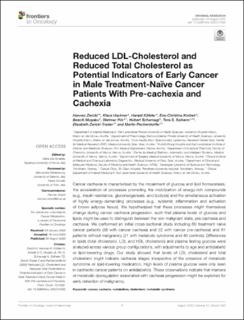| dc.contributor.author | Zwickl, Hannes | |
| dc.contributor.author | Hackner, Klaus | |
| dc.contributor.author | Köfeler, Harald | |
| dc.contributor.author | Krzizek, Eva-Christina | |
| dc.contributor.author | Muqaku, Besnik | |
| dc.contributor.author | Pils, Dietmar | |
| dc.contributor.author | Scharnagl, Hubert | |
| dc.contributor.author | Solheim, Tora S | |
| dc.contributor.author | Zwickl-Traxler, Elisabeth | |
| dc.contributor.author | Pecherstorfer, Martin | |
| dc.date.accessioned | 2021-07-21T10:03:37Z | |
| dc.date.available | 2021-07-21T10:03:37Z | |
| dc.date.created | 2021-01-13T14:08:20Z | |
| dc.date.issued | 2020 | |
| dc.identifier.citation | Frontiers in Oncology. 2020, 10 (1262), . | en_US |
| dc.identifier.issn | 2234-943X | |
| dc.identifier.uri | https://hdl.handle.net/11250/2764878 | |
| dc.description.abstract | Cancer cachexia is characterized by the impairment of glucose and lipid homeostasis, the acceleration of processes promoting the mobilization of energy-rich compounds (e.g., insulin resistance, gluconeogenesis, and lipolysis) and the simultaneous activation of highly energy-demanding processes (e.g., systemic inflammation and activation of brown adipose tissue). We hypothesized that these processes might themselves change during cancer cachexia progression, such that plasma levels of glucose and lipids might be used to distinguish between the non-malignant state, pre-cachexia and cachexia. We performed an initial cross-sectional study including 60 treatment naïve cancer patients (38 with cancer cachexia and 22 with cancer pre-cachexia) and 61 patients without malignancy (21 with metabolic syndrome and 40 controls). Differences in lipids (total cholesterol, LDL and HDL cholesterol) and plasma fasting glucose were analyzed across various group configurations, with adjustments to age and antidiabetic or lipid-lowering drugs. Our study showed that levels of LDL cholesterol and total cholesterol might indicate cachexia stages irrespective of the presence of metabolic syndrome or lipid-lowering medication. High levels of plasma glucose were only seen in cachectic cancer patients on antidiabetics. These observations indicate that markers of metabolic dysregulation associated with cachexia progression might be exploited for early detection of malignancy. | en_US |
| dc.language.iso | eng | en_US |
| dc.publisher | Frontiers Media | en_US |
| dc.rights | Navngivelse 4.0 Internasjonal | * |
| dc.rights.uri | http://creativecommons.org/licenses/by/4.0/deed.no | * |
| dc.title | Reduced LDL-Cholesterol and Reduced Total Cholesterol as Potential Indicators of Early Cancer in Male Treatment-Naïve Cancer Patients With Pre-cachexia and Cachexia | en_US |
| dc.type | Peer reviewed | en_US |
| dc.type | Journal article | en_US |
| dc.description.version | publishedVersion | en_US |
| dc.source.volume | 10 | en_US |
| dc.source.journal | Frontiers in Oncology | en_US |
| dc.source.issue | 1262 | en_US |
| dc.identifier.doi | 10.3389/fonc.2020.01262 | |
| dc.identifier.cristin | 1870712 | |
| dc.description.localcode | Copyright © 2020 Zwickl, Hackner, Köfeler, Krzizek, Muqaku, Pils, Scharnagl, Solheim, Zwickl-Traxler and Pecherstorfer. This is an open-access article distributed under the terms of the Creative Commons Attribution License (CC BY). The use, distribution or reproduction in other forums is permitted, provided the original author(s) and the copyright owner(s) are credited and that the original publication in this journal is cited, in accordance with accepted academic practice. No use, distribution or reproduction is permitted which does not comply with these terms. | en_US |
| cristin.ispublished | true | |
| cristin.fulltext | original | |
| cristin.qualitycode | 1 | |

